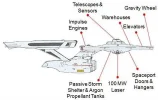- Joined
- Jun 4, 2006
- Messages
- 102
- Reaction score
- 0
From here.By Nancy Atkinson
Universe Today
updated 5/12/2012 12:13:38 AM ET

In Star Trek lore, the first Starship Enterprise will be built by the year 2245. But today, an engineer has proposed — and outlined in meticulous detail — building a full-sized, ion-powered version of the Enterprise complete with 1G of gravity on board, and says it could be done with current technology, within 20 years.
"We have the technological reach to build the first generation of the spaceship known as the USS Enterprise — so let's do it," writes the curator of the Build The Enterprise website, who goes by the name of BTE Dan.
This "Gen1" Enterprise could get to Mars in 90 days, to the moon in three, and "could hop from planet to planet dropping off robotic probes of all sorts en masse — rovers, special-built planes and satellites,” BTE Dan says.
Complete with conceptual designs, ship specs, a funding schedule and almost every other imaginable detail, the BTE website was launched just this week and covers almost every aspect of how the project could be done. This Enterprise would be built entirely in space, have a rotating gravity section inside of the saucer, and be similar in size with the same look as the USS Enterprise that we know from classic "Star Trek."
“It ends up that this ship configuration is quite functional,” writes BTE Dan, even though his design moves a few parts around for better performance with today’s technology. This version of the Enterprise would be three things in one: a spaceship, a space station and a spaceport. A thousand people can be on board at once — either as crew members or as adventurous visitors.
While the ship will not travel at warp speed, with an ion propulsion engine powered by a 1.5GW nuclear reactor, it can travel at a constant acceleration so that the ship can easily get to key points of interest in our solar system. Three additional nuclear reactors would create all of the electricity needed for operation of the ship.
The saucer section would be a 0.3-mile-diameter (536-meter-diameter) rotating, magnetically suspended gravity wheel that would create 1G of gravity.
The first assignments for the Enterprise would have the ship serving as a space station and spaceport, but then go on to missions to the moon, Mars, Venus, various asteroids and even Europa, where the ship's laser would be used not for combat but for cutting through the moon's icy crust to enable a probe to descend to the ocean below.
And from Yahoo News:
And here's BTE Dan's BuildTheEnterprise website, where he as a video showing how the gravity wheel works, and he talks about the articles that talk about him. Maybe we'll get to meet up with the Klingons after allWhether you're a Trekkie or not, you have to admit that there's some sense of wonder toexploring the stars and trying to find life on distant planets. Of course, the U.S.S. Enterprise is a fictional ship, but have you ever put in the thought as to what it would take to actually build it, and when we could get it done if we really put in the effort? The man behind the well-researched site buildtheenterprise.org has, and he's determined that a fully functional Enterprise is only 20 years away if we put in the effort.
Created by a systems and electrical engineer with 30 years' experience, the BuildTheEnterprise site sets out a very specific timeline for the research and construction of such a massive space-related undertaking. The first nine years are dedicated to research, component testing, and drawing up a number of possible blueprints. The following 11 years are dedicated to development, where components will be manufactured and launched into space for assembly.
On year 20, the ship would be ready for a "moon fly by" with full crew and supplies. The plan may seem overly ambitious, but consider that we're already using a number of gadgets that were all but predicted by the Star Trek television series.
The estimated cost of building the Enterprise: about $50 billion a year for the next 20 years — $1 trillion in total. That sounds like a lot of money (because it is), but considering that the United States spent nearly that much on the controversial Troubled Asset Relief Program (TARP) to bail out banks in 2008, putting a trillion towards making Star Trek a reality suddenly doesn't seem as ludicrous. Yeah, it's still pretty ludicrous, but in a reallycool way.
Asides from the benefits of exploring space, the creator of BuildTheEnterprise believes that the mammoth project would have benefits here on Earth as well. "Above all else — the Enterprise will inspire us," explains the creator. "And some of those inspired by this undertaking will surely be American young people — many of whom will likely become motivated to pursue careers as scientists and engineers." You know, so long as creating a warp drive doesn't wipe out all life in the known universe, as predicted.





